Welcome! Many gamers don’t have a large group of people to play with on a regular basis. Our main gaming partners are our significant others, or our children, or roommates, or a co-worker or… well, you get the drift. Whatever the case may be, often times we find ourselves sitting across the table from another person with nothing to do. In this series of articles, we will be turning our focus on some great 2-player only games that can fill that void!
Overview
Today we’ll be talking about Lost Cities. Created by the incredible mind of Reiner Knizia, it’s a card game about mounting expeditions to go exploring ancient ruins. In Lost Cities, each player begins with a handful of cards and then, one by one, they will play those cards onto one of several board locations to mount expeditions. The numbers on the card represent the amount of money each expedition will generate. Each expedition costs a certain amount of money to mount in the first place, so players are aiming to make a profit or break even. The game is played three times in a row and the person with the highest accumulated score at the end of the third game is the winner.
Components
Lost Cities comes in a pretty small package. Opening the box you’ll find a small, four-page rule book, one game board divided into five different colored areas (yellow, blue, white, green, and red), and one deck of cards. The deck is divided into five different suits (the colors mentioned previously) and numbered from 2-10 with three “wager” cards for each suit. I’ll discuss the wager cards and how they affect the game in a little bit.
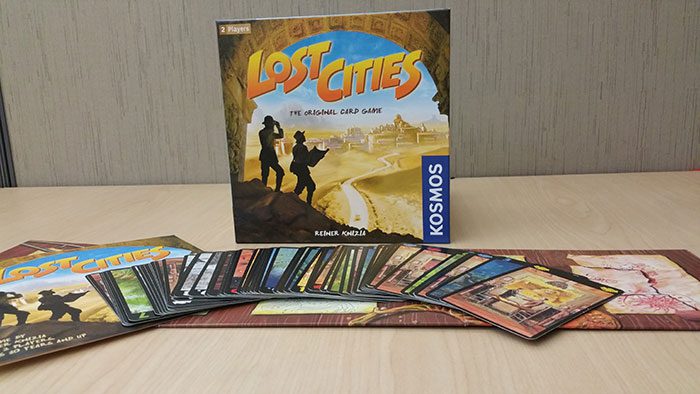
The rulebook is well written and heavily illustrated with a good amount of examples to drive home the various aspects of the game. The game board is thick and sturdy but due to its tri-fold nature, it tends to bow at one of the creases. The cards themselves are of pretty poor quality. They’re rather large and flimsy, so you might consider sleeving them if you wind up purchasing the game.
Setup
First the game board is laid out between the two players. Then the cards are shuffled thoroughly and each player draws eight cards apiece.
That’s it. You’re ready to play.
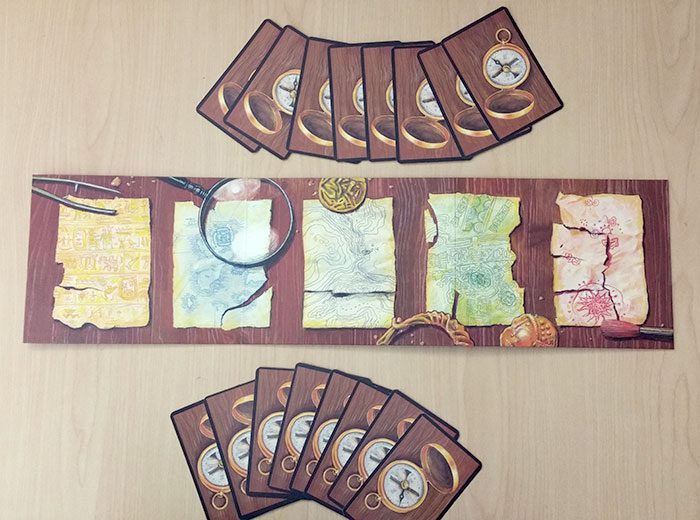
Anatomy of a Game
The rules of the game are pretty simple. Starting with the first player, each person takes turns either placing a card into one of their own columns or discarding a card into the matching colored area on the game board. Then the player will draw a new card to replace the one they just got rid of. They can either draw from the deck OR they can draw the top card of one of the discard piles, but they cannot draw a card that they just discarded.
So, let’s discuss this in a little more detail.
Let’s say you’ve got a hand with several blue cards in it, so you think it might be a good idea to go on a blue expedition. To begin mounting your expedition, you would select a blue card from your hand and lay it down on your side of the board next to the blue space. The next blue card that you played would have to be of a higher value than the previously played card.
The numbered cards start with 2 and range all the way up to 10. If you want to, you can begin your expedition by placing a wager card. A single wager card doubles the overall value of the expedition at the end of the game. Two wager cards triple it. Three wager cards quadruple it. The wager cards can only be played at the start of an expedition so they must be the first cards played.
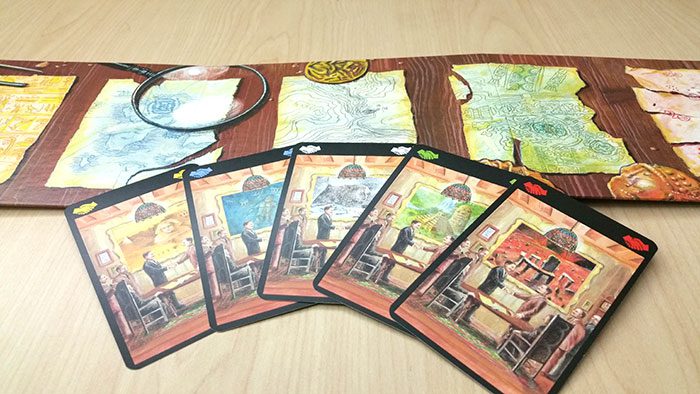
But maybe you’re in a situation where you’d rather discard a card than play a card. Perhaps you’ve got a low numbered blue and several high valued ones and you don’t want to just jump directly from a low number to a high number. Or maybe you just don’t have any good options at all. In a case such as these, you can simply select a card from your hand and then discard it to the discard pile of the same color. White cards are discarded to the white pile, for instance.
After you’ve played your card or discarded, then you must draw a card. You can never draw the card that you just discarded, but you do have the choice between drawing from the main deck OR drawing from any one of the discard piles. Obviously, if the only card in the middle of the board is the one that you just now discarded, then your only option at that point would be to draw from the deck. This cycle of playing/discarding and then drawing back up continues until the last card is drawn from the main deck at which time scoring is performed.
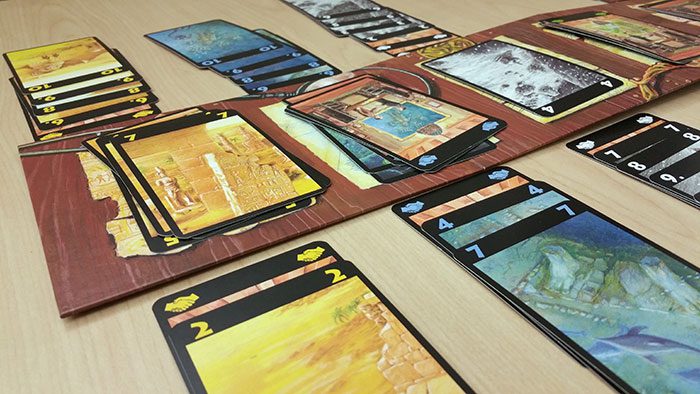
Scoring
The scoring is quite possibly the most difficult part of this game. It can feel very math heavy your first few times, so I’ll break it down as best I can.
Each expedition costs a total of $20 to mount. That means that if you even laid a single card next to a color, you’re already at a $20 deficit. Keeping this in mind, you’ll add up the total value of all of the numbered cards in each location and then multiply that total by 2/3/4 for every 1/2/3 wager cards that are present. This may result in a very large negative number. This math is performed for each expedition that you mounted. Locations that have not had any cards played to them do not count. Each expeditions with eight or more cards receives 20 bonus points. Finally, you add the 5 totals together and this is your score for this game. After three games, the player with the highest total is the winner.
Just to make this even easier to understand, consider the example in the image below:
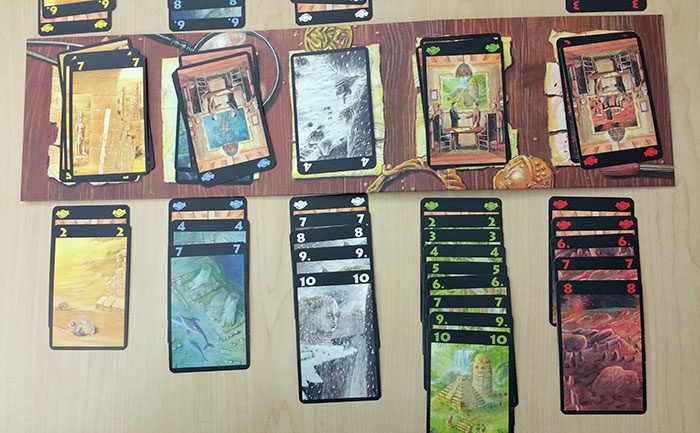
Starting from left to right:
Yellow: 1 wager plus 2. That’s 2 points plus -20 for a total of -18. Double that for a total of -36. This was not a profitable expedition at all!
Blue: 1 wager card. 4 + 7 = 11. 11 plus negative 20 is -9. Double that and you wind up with -18. Not as bad as yellow, but still pretty bad.
White: 1 wager card. 7+8+9+10 = 34. 34 plus negative 20 = 14. Double that for positive 28. Getting better!
Green: 1 wager card. 2+3+4+5+6+7+9+10 = 46. 46 – 20 = 26. Double that for 52 points. Then, since there were at least 8 cards used, add another 20 for a total of 72!
Red: 2 wager cards. 6+7+8 = 21. 21 plus negative 20 = 1. Triple that for a total of 3 points. It wasn’t a total bust, but at least it was profitable.
Add up the 5 expeditions: (-36) + (-18) + 28 + 72 + 3 for a total of 49 points for this game.
Thoughts
I’d like to begin here by commenting on the artwork. It’s gorgeous. The folks at Grafik Studio Krüger have done a brilliant job of creating environments that really evoke the whole “exploring ancient ruins” theme. A hidden bonus is that, for each color, arranging the cards in a certain way creates an entirely new work of art. I think that’s just awesome! Here’s an example:
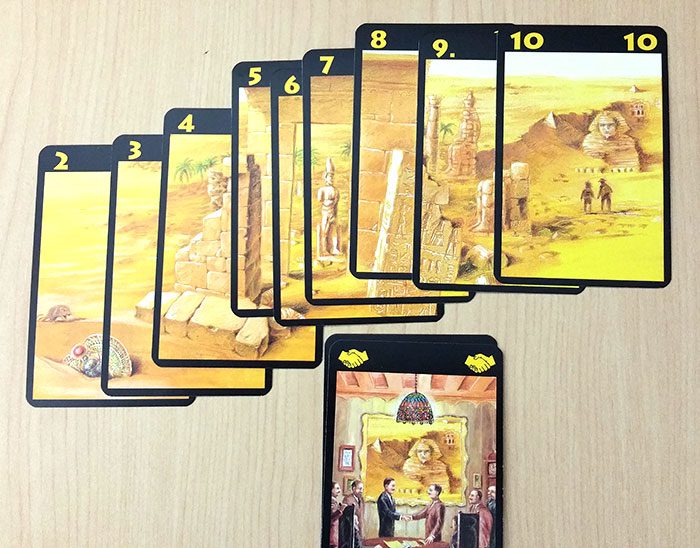
As for the gameplay, on the surface, Lost Cities seems like a pretty straightforward game. Play/discard a card. Draw a card. Repeat. It’s a very simple game to play which makes it a very easy game to teach and jump right into. However, despite the short rules description, this game is anything but simple.
Lost Cities presents the players with a lot of unique challenges for them to overcome. When you’re looking at your opening hand, if you’re lucky, you’ll find yourself holding several cards of the same color. This can often be a very useful guide as to which cards you need to play next. More often than not, though, you’re going to find yourself holding a wide array of colors and numbers. Mounting any expedition at that point could be tantamount to suicide because you never know what the deck is going to throw at you next, or which cards your opponent might be holding. So, this game is challenging you to make a tough decision from the very first turn of the game.
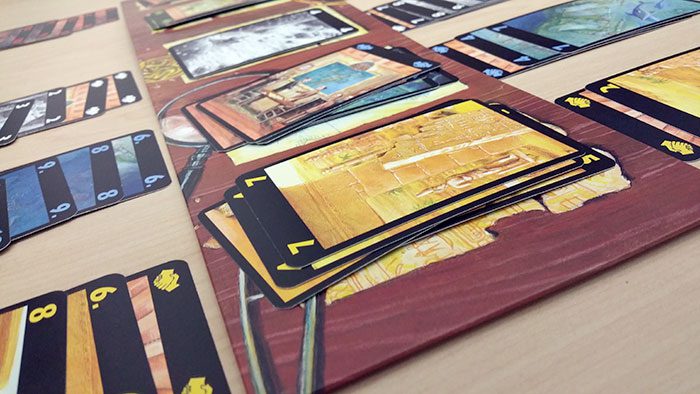
If you discard a card from your hand, it might wind up being exactly what your opponent needs. But, if you play a card from your hand, it could wind up being the only card that you see of that specific color for the rest of the game which could wind up costing you a ton of points. Should you discard or play a card? It’s a tough call when you’ve only got limited information in your hand. And this is a game all about doing your best with the limited information at your disposal.
Another interesting decision comes towards the end of the game when you’ve got a rapidly dwindling main deck, but still have a handful of expedition cards. If you keep drawing from the main deck, you’ll bring the game to an end more quickly. However, if you and your opponent are drawing from the discard piles, you can stretch things out a bit. So, you might wind up in a situation where seeding the discard piles with cards that help out your opponent might be something that you want to do just to lure them into avoiding the main deck as well. Or you might decide to go the opposite way and try to end things as quickly as possible if you’re doing well.
Lost Cities is full of decision making moments like these that really keep the players involved. Mix that with the incredibly easy rules and the very quick game play and you’ve got a game that’s sure to appeal to a very wide audience. It’s easy enough for a first time gamer to play and it’s challenging enough that even a seasoned veteran will stay intrigued. I love this game and the fact that my wife loves it as much as I do makes it even better. We think you’ll like it, too!
What do you think of Lost Cities? Tell us in the comments below!











